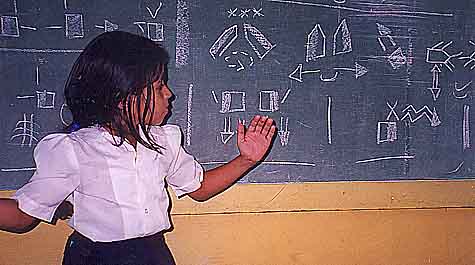|

Email Messages, October, 1998
Date: Thu, 8 Oct 1998 10:36:43 -0400
Sender: SignWriting List <SW-L@ADMIN.HUMBERC.ON.CA>
Subject: Re: Writing ASL Grammar
This time the sender really is "Judy Kegl" and not
James!
One thing we are doing in Bluefields (Nica) is tagging signed
language
texts. The kids work with pages in signwriting or texts from
their
signwritten books and they underline and annotate in different
colors
things like noun, verb, adj, adverb, pronoun as well as subject,
object
etc. This is something that could be done with ASL texts as well
and might
prove useful to someone like Cheryl, even more useful than a
grammar lesson
per se in SW.
Just a thought.
--Judy
kegl@maine.rr.com

Date: Mon, 26 Oct 1998 19:30:08 -0500
Sender: SignWriting List <SW-L@ADMIN.HUMBERC.ON.CA>
Subject: Re: SW Symbol Questions
Regarding the "smooth" line, in Nicaragua we don't
use it anymore. That's
a judgment call -- and I am not saying whether or not it was
a good one,
but I thought I'd let you all know anyway. We use the "slow"
sign
frequently, but were unable to differentiate when a sign was
"smooth" as
opposed to "slow", so we just call all the slows and
smoothies "slow". We
do distinguish between "slow/smooth" and "very
slow" (by using the
double-slow dynamic indicator. Also, we alway put the dynamic
markers on
the bottom, except for the tension dynamic marker which for us
has two
meanings depending upon its location. (For us, a tension marker
on top of
an arrow point indicates that the hand movement stops abruptly.)
There are times when I wonder if we really need to use the
symmetry marker
(as opposed to the asymmetry markers) rather than assuming symmetry
by
default in the absence of the marker. Personally, I find the
symmetry
marker enhances the readability of the sign.
We've made some other adaptations -- we think we've done some
tweaking up,
as suits our particular needs. Others might disagree --- but
then my ego
is made of pretty stern stuff.
All in all, we are 99.9% faithful to Valerie's system.
--
James Shepard-Kegl
kegl@maine.rr.com

Date: Tue, 27 Oct 1998 11:52:16 -0500
Sender: SignWriting List <SW-L@ADMIN.HUMBERC.ON.CA>
Subject: Re: Canadian Geography Inquiry
To any Canadian signers:
We are in designing an SW reading leeson regarding Lindbergh
for our
school in Nicaragua. While Nicaraguan has a distinct sign for
"Canada"
(which is unlike the ASL sign), there are no signs for either
Nova Scotia
or Newfoundland. In such situations, we usually borrow the sign
used by
the locals in the geographical location in question.
Anybody know the sign for "Nova Scotia" or "Newfoundland"?
To any French signers: same problem for "Paris".
(Nicaraguan Sign
Language already has a sign for France.)
-- James Shepard-Kegl
kegl@maine.rr.com

Date: Tue, 27 Oct 1998 12:06:13 -0500
Sender: SignWriting List <SW-L@ADMIN.HUMBERC.ON.CA>
Subject: Re: Frequently-Asked Questions
This is one of those issues that my wife Judy can address
with inspiring
eloquence, but I am more earthy by nature.
The terrific thing about SW is that it is not really all that
iconic.
Rather, the system sets forth a clear and readily understanbale
CODE which
allows the reader to reliably predict the "spelling"
of the sign. In
short, SW is a visually phonetic coding system. (One might argue
how much
a specific sign language may be iconic, but SW most definitely
is not.)
It takes years and years of schooling to learn to write Chinese
-- each
written form must be memorized by rote. One can master SW in
a matter of
days.
-- James Shepard-Kegl
kegl@maine.rr.com

Date: Thu, 29 Oct 1998 23:09:15 -0500
Sender: SignWriting List <SW-L@ADMIN.HUMBERC.ON.CA>
Subject: Re: iconicity
Having taught SW intensively for a couple of years now, my
impression is
that Deaf children learn to read SW exactly the same way hearing
children
learn to read english -- which, of course, is the point. We teach
english
reading through a phonetic system, but, actually, children for
the most
part learn through whole word recognition --- resorting only
to phonetic
decoding for unfamiliar words. The Deaf children in our program
quickly
learn SW in exactly the same manner, and therefore with some
experience can
recognize SW words in small print instantly. -- James Shepard-Kegl,
Escuelita de Bluefields, Nicaragua
-- James Shepard-Kegl
kegl@maine.rr.com

|
...two schools for the Deaf in Nicaragua...
Escuelita de Bluefields
Escuelita de Condega
...were founded by...
...and are coordinated by...
Nicaraguan Sign Language Projects, Inc.
James Shepard-Kegl, Coordinator
52 Whitney Farms Road
North Yarmouth, Maine, 04097, USA
(207) 846-8801 voice or tty
(207) 846-8688 fax
Email: kegl@maine.rr.com
|
|
